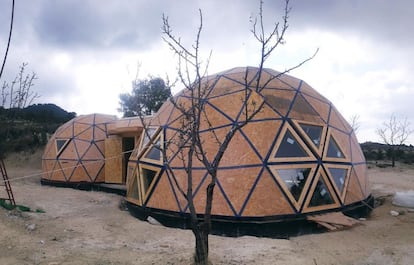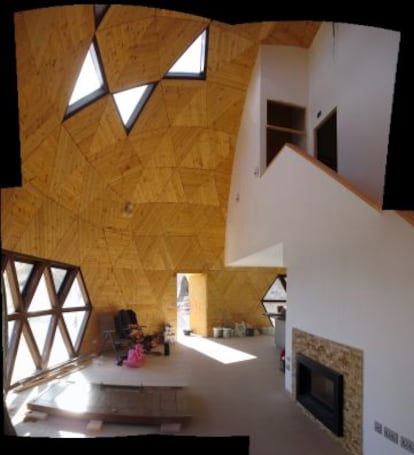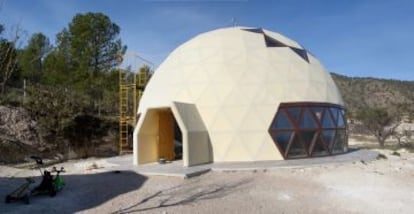The dome home comes to Spain
Architecture firm builds two geodesic houses in Murcia for British and Norwegian families

A Spanish architecture company is now putting the finishing touches to two circular, geodesic houses in the southern region of Murcia that will be home to a British family and a Norwegian couple. The first of the wood-built structures is in Yecla, and has a floor space of 160 square meters; the second, in the wine-growing area of Jumilla, is made up of two igloo-like constructions joined by a corridor that together provide 85 square meters of living space.
“It’s a way of covering a circular space very efficiently by joining together triangular panels: this cuts down the amount of material that needs to be used, reducing building times and costs,” explain architects Pablo Carbonell and Juan Miguel Galera Miñarro from Ecoproyecta, which is building the homes.
The appeal of using geodesic domes is that they cost between €500 and €1,000 per square meter
The geodesic dome is not a new invention: US architect Buckminster Fuller was designing such structures in the mid-20th century – he built a 75-meter-diameter dome for the US pavilion at the Canada Expo in 1967, held in Montreal. Later, other architects, among them Spain’s Emilio Pérez Piñero, further refined Fuller’s designs in the 1970s.
Ecoproyecta has now revived the concept, allowing its clients to use renewable energy from solar panels and batteries to store electricity, making homes self-sufficient. There are also options to recycle rainwater.

The appeal of using geodesic domes is that they cost between €500 and €1,000 per square meter, and take around six months to build. “The house in Yecla cost around €150,000 (€900 per square meter, including solar panel installation), while the home in Jumilla has cost around €45,000 (€550 per square meter), along with €3,000 for solar panels. You need to bear in mind that the first house is better equipped, with under-floor heating, a chimney that acts as a biomass-fueled boiler, and generally more expensive material,” says Carbonell. Both homes generate their own electricity.
The larger property, in Yecla, will be home to a British family of five, while a Norwegian couple has bought the house in Jumilla. Both structures will be primary residences.
The geodesic domes’ triangular panels are assembled in Ecoproyecta’s workshop first, and then the dome itself is built on a cement foundation and covered with either a waterproof laminate and mortar or natural cork in just a couple of days. The flooring and interior work, electricity, water, and so forth takes up most of the construction time.

Size is not an issue: any number of domes can be connected via passageways or corridors. “By adding domes you can create a property as big as you like. What’s more, you can increase the size as and when you need, for example, when you have more children [...] or want guest bedrooms,” says Carbonell.
The domed interior is an open space without walls. The homes use biomass open fires for heating, while geothermic ventilation is provided by the Canadian well system, producing heat in winter and cold air in summer. Both homes are built on open land with trees that can be pruned for firewood.
Ecoproyecta says interest in geodesic dome houses is growing in Spain, albeit slowly, and that it has just presented four new estimates for properties.
Tu suscripción se está usando en otro dispositivo
¿Quieres añadir otro usuario a tu suscripción?
Si continúas leyendo en este dispositivo, no se podrá leer en el otro.
FlechaTu suscripción se está usando en otro dispositivo y solo puedes acceder a EL PAÍS desde un dispositivo a la vez.
Si quieres compartir tu cuenta, cambia tu suscripción a la modalidad Premium, así podrás añadir otro usuario. Cada uno accederá con su propia cuenta de email, lo que os permitirá personalizar vuestra experiencia en EL PAÍS.
¿Tienes una suscripción de empresa? Accede aquí para contratar más cuentas.
En el caso de no saber quién está usando tu cuenta, te recomendamos cambiar tu contraseña aquí.
Si decides continuar compartiendo tu cuenta, este mensaje se mostrará en tu dispositivo y en el de la otra persona que está usando tu cuenta de forma indefinida, afectando a tu experiencia de lectura. Puedes consultar aquí los términos y condiciones de la suscripción digital.
More information
Últimas noticias
David Bowie, the galactic thinker who encouraged us to break new ground
John Berger and the loss of rural culture
From police officer to bloodthirsty kidnapper: Terror in Mexico during the years of ‘The Ear Chopper’
Alain Aspect, Nobel laureate in physics: ‘Einstein was so smart that he would have had to recognize quantum entanglement’
Most viewed
- David King, chemist: ‘There are scientists studying how to cool the planet; nobody should stop these experiments from happening’
- Reinhard Genzel, Nobel laureate in physics: ‘One-minute videos will never give you the truth’
- Oona Chaplin: ‘I told James Cameron that I was living in a treehouse and starting a permaculture project with a friend’
- Mexico completes its trade shift with the entry into force of tariffs on China and countries without trade agreements
- Sinaloa Cartel war is taking its toll on Los Chapitos











































